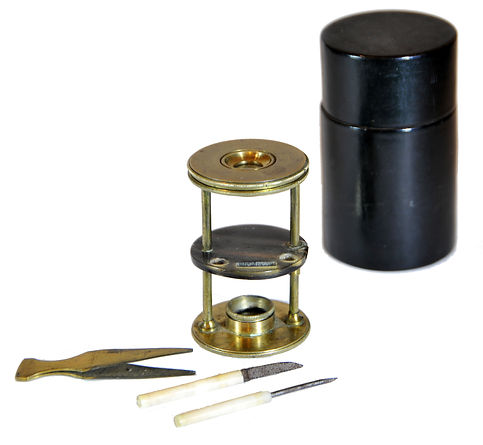

Withering-type botanical microscope, 1780
The “Withering-type Microscope” is named for its inventor, Dr. William Withering (1741-1799), an English physician and botanist who graduated with a degree in medicine 1766 in Edinburgh. Inspired by the taxonomical work and systematic classification of Carl Linnæus (1707-1778), Withering (1776) applied the Linnaean taxonomical system of classification to British plants in a seminal, two volume work, A Botanical arrangement of all the vegetables naturally growing in the British Isles. The earliest reference to a small botanical microscope of Withering’s design appeared in the first edition of this book. There, Withering indicated this microscope was developed for field dissections of flowers and other plant parts. While there is no surviving example of this exact design, close relatives of this type do exist, made either completely of brass or of ivory with brass pillars. Ivory models can be tentatively dated to 1776-1785, as by 1787 a newer model with a hollowed stage in an all-brass configuration already predominated. In turn, it was preceded by the brief appearance of a transitional brass model but with solid stage of ivory or horn (seen here). This version is extremely rare and must have been produced in very small numbers. By 1787 all these varieties were not recorded anymore in the literature.

Withering-type botanical microscope, 1780
The “Withering-type Microscope” is named for its inventor, Dr. William Withering (1741-1799), an English physician and botanist who graduated with a degree in medicine 1766 in Edinburgh. Inspired by the taxonomical work and systematic classification of Carl Linnæus (1707-1778), Withering (1776) applied the Linnaean taxonomical system of classification to British plants in a seminal, two volume work, A Botanical arrangement of all the vegetables naturally growing in the British Isles. The earliest reference to a small botanical microscope of Withering’s design appeared in the first edition of this book. There, Withering indicated this microscope was developed for field dissections of flowers and other plant parts. While there is no surviving example of this exact design, close relatives of this type do exist, made either completely of brass or of ivory with brass pillars. Ivory models can be tentatively dated to 1776-1785, as by 1787 a newer model with a hollowed stage in an all-brass configuration already predominated. In turn, it was preceded by the brief appearance of a transitional brass model but with solid stage of ivory or horn (seen here). This version is extremely rare and must have been produced in very small numbers. By 1787 all these varieties were not recorded anymore in the literature.
References: SML: A242712; Goren 2014.
References: SML: A242712; Goren 2014.
Prof. Yuval Goren's Collection of the History of the Microscope

Carpenter & Westley, New Improved Compound Microscope for Opake and Transparent Objects, 1835
Philip Carpenter (1776–1833) was a maker of scientific instruments starting in 1808. The original location of the shop was in Birmingham, but later he moved to Regent Street, London, where he also opened a public gallery and shop called "the Microcosm." He worked at this location until his death in 1833. After Philip's death his sister Mary took over the firm along with her husband William Westley. Soon thereafter (1835) firm changed its name to "Carpenter & Westley". Their manufacture of scientific instruments gradually decreased into the1850s until finally the firm of Carpenter & Westley evolved entirely into sales. At that time the manufacture of instruments was done by the firm of Negretti and Zambra until Carpenter & Westley closed shop permanently in 1914.
The "Improved Compound Microscope" was Carpenter's best instrument. It was later sold by Carpenter & Westley, the address on this item (111 New St., Birmingham) suggests an early date of ca. 1835.
Provenance: Previously from the collection of Prof. Brian Stevenson, Lexington, Kentucky, USA.
References: MHS: 10248, 34404; NMS: 000-180-000-159-C; Whipple 1136; Bonhams 2011; Ars Machina; Golub; Wissner.
